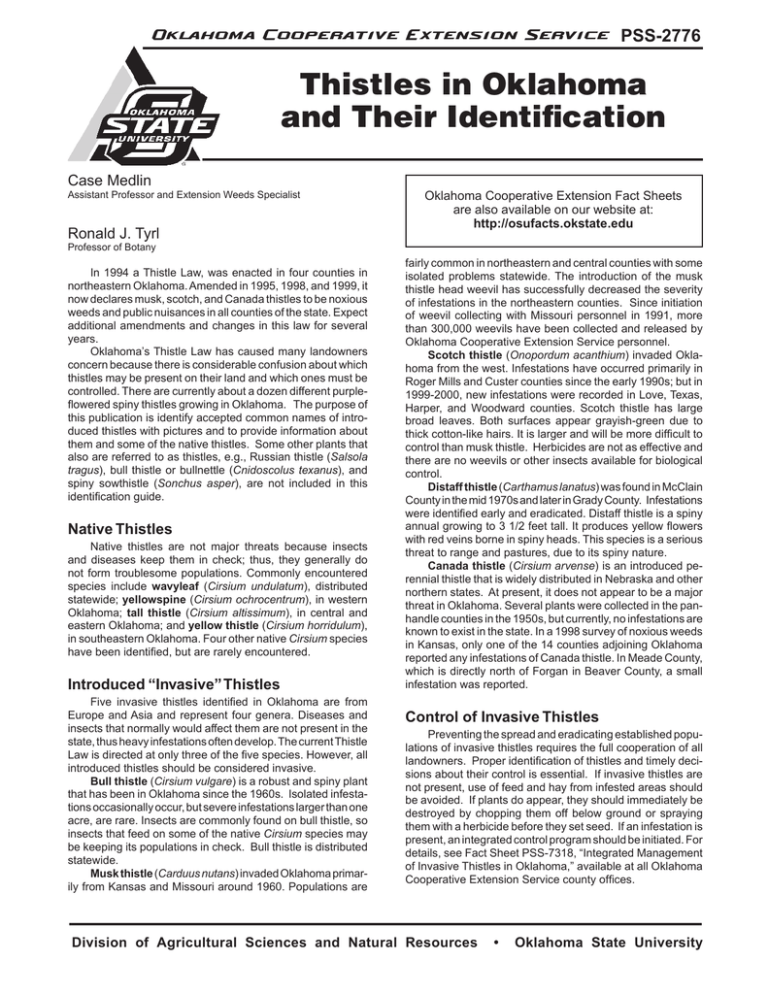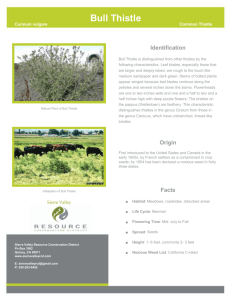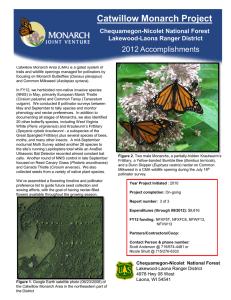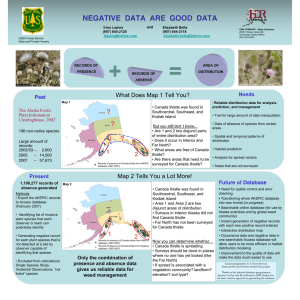Thistles in Oklahoma and Their Identification PSS-2776 Case Medlin
advertisement

Oklahoma Cooperative Extension Service PSS-2776 Thistles in Oklahoma and Their Identification Case Medlin Assistant Professor and Extension Weeds Specialist Ronald J. Tyrl Oklahoma Cooperative Extension Fact Sheets are also available on our website at: http://osufacts.okstate.edu Professor of Botany In 1994 a Thistle Law, was enacted in four counties in northeastern Oklahoma. Amended in 1995, 1998, and 1999, it now declares musk, scotch, and Canada thistles to be noxious weeds and public nuisances in all counties of the state. Expect additional amendments and changes in this law for several years. Oklahoma’s Thistle Law has caused many landowners concern because there is considerable confusion about which thistles may be present on their land and which ones must be controlled. There are currently about a dozen different purpleflowered spiny thistles growing in Oklahoma. The purpose of this publication is identify accepted common names of introduced thistles with pictures and to provide information about them and some of the native thistles. Some other plants that also are referred to as thistles, e.g., Russian thistle (Salsola tragus), bull thistle or bullnettle (Cnidoscolus texanus), and spiny sowthistle (Sonchus asper), are not included in this identification guide. Native Thistles Native thistles are not major threats because insects and diseases keep them in check; thus, they generally do not form troublesome populations. Commonly encountered species include wavyleaf (Cirsium undulatum), distributed statewide; yellowspine (Cirsium ochrocentrum), in western Oklahoma; tall thistle (Cirsium altissimum), in central and eastern Oklahoma; and yellow thistle (Cirsium horridulum), in southeastern Oklahoma. Four other native Cirsium species have been identified, but are rarely encountered. Introduced “Invasive” Thistles Five invasive thistles identified in Oklahoma are from Europe and Asia and represent four genera. Diseases and insects that normally would affect them are not present in the state, thus heavy infestations often develop. The current Thistle Law is directed at only three of the five species. However, all introduced thistles should be considered invasive. Bull thistle (Cirsium vulgare) is a robust and spiny plant that has been in Oklahoma since the 1960s. Isolated infestations occasionally occur, but severe infestations larger than one acre, are rare. Insects are commonly found on bull thistle, so insects that feed on some of the native Cirsium species may be keeping its populations in check. Bull thistle is distributed statewide. Musk thistle (Carduus nutans) invaded Oklahoma primarily from Kansas and Missouri around 1960. Populations are fairly common in northeastern and central counties with some isolated problems statewide. The introduction of the musk thistle head weevil has successfully decreased the severity of infestations in the northeastern counties. Since initiation of weevil collecting with Missouri personnel in 1991, more than 300,000 weevils have been collected and released by Oklahoma Cooperative Extension Service personnel. Scotch thistle (Onopordum acanthium) invaded Oklahoma from the west. Infestations have occurred primarily in Roger Mills and Custer counties since the early 1990s; but in 1999-2000, new infestations were recorded in Love, Texas, Harper, and Woodward counties. Scotch thistle has large broad leaves. Both surfaces appear grayish-green due to thick cotton-like hairs. It is larger and will be more difficult to control than musk thistle. Herbicides are not as effective and there are no weevils or other insects available for biological control. Distaff thistle (Carthamus lanatus) was found in McClain County in the mid 1970s and later in Grady County. Infestations were identified early and eradicated. Distaff thistle is a spiny annual growing to 3 1/2 feet tall. It produces yellow flowers with red veins borne in spiny heads. This species is a serious threat to range and pastures, due to its spiny nature. Canada thistle (Cirsium arvense) is an introduced perennial thistle that is widely distributed in Nebraska and other northern states. At present, it does not appear to be a major threat in Oklahoma. Several plants were collected in the panhandle counties in the 1950s, but currently, no infestations are known to exist in the state. In a 1998 survey of noxious weeds in Kansas, only one of the 14 counties adjoining Oklahoma reported any infestations of Canada thistle. In Meade County, which is directly north of Forgan in Beaver County, a small infestation was reported. Control of Invasive Thistles Preventing the spread and eradicating established populations of invasive thistles requires the full cooperation of all landowners. Proper identification of thistles and timely decisions about their control is essential. If invasive thistles are not present, use of feed and hay from infested areas should be avoided. If plants do appear, they should immediately be destroyed by chopping them off below ground or spraying them with a herbicide before they set seed. If an infestation is present, an integrated control program should be initiated. For details, see Fact Sheet PSS-7318, “Integrated Management of Invasive Thistles in Oklahoma,” available at all Oklahoma Cooperative Extension Service county offices. Division of Agricultural Sciences and Natural Resources • Oklahoma State University Vegetative Key to the Most Commonly Encountered Purple-Flowered Thistles in Oklahoma These thistles produce conspicuous rosettes of leaves as seedlings. Leaves of rosette and upper blades are ovate or lanceolate to oblanceolate; the margins are generally lobed and tipped with spines. Flowers are usually purple. Leaves illustrated in this key are upper surfaces of young leaves. Leaf lobes usually become deeper-cut, and spines become more numerous on older Start here with unknown thistle and follow arrows to identify. ➛ Hairs or fuzz not present on either upper or lower leaf surfaces. ➛ ➛ ➛ Leaf margins often silvery. Leaf margins not silvery. ➛ Musk thistle (Carduus nutans), See 4D and 5D on pages 4 and 5. Yellow thistle (Cirsium horridulum), See 3C and 6C on pages 3 and 6. ➛ Hairs or fuzz on upper and/or lower leaf surfaces. ➛ Upper surfaces dark green. Spines weak. ➛ Leaf surfaces different colors; upper greenish; lower whitish. ➛ Upper and lower leaf surfaces similar colors. ➛ Leaves shallowly lobed; cottony gray-green. ➛ Scotch thistle (Onopordum acanthium), ➛ See 4E and 5E on pages 4 and 5. Tall thistle (Cirsium altissimum), ➛ See 3A and 6A on pages 3 and 6. ➛ Upper surfaces light green to grayish. Spines stout. ➛ Spines yellow 1/4 - 3/8 inch long. Leaves deeply lobed; green appearance. Upper surfaces prickly and leathery. ➛ Bull thistle (Cirsium vulgare), See ➛ 4A and 5A on pages 4 and 5. Yellowspine thistle (Cirsium ochro➛ centrum), See 3D and 6D on pages 3 and 6. ➛ ➛ Upper surfaces waxy. Spines white; 1/8 - 1/4 inch long. ➛ Canada thistle (Cirsium arvense), See 4B and 5B on pages 4 and 5. Wayleaf thistle (Cirsium undulatum), See 3B and 6B on pages 3 and 6. PSS-2776- 3A. Tall Thistle (Cirsium altissimum). 3C. Yellow Thistle (Cirsium horridulum). Photo compliments of Weeds of the West. Photo by Ron Tyrl. Photo compliments of Rodney Lyn, North Dakota State Extension Service. Photo compliments of Rodney Lyn, North Dakota State Extension Service. Native Thistles 3B. Wavyleaf Thistle (Cirsium undulatum). 3D. Yellowspine Thistle (Cirsium ochrocentrum). PSS-2776-3 Photos compliments of Weeds of the West. 4C. Distaff Thistle (Carthamus lanatus). 4D. Musk Thistle (Carduus nutans). Photo by Jim Stritzke. 4B. Canada Thistle (Cirsium arvense). Photo by Jim Stritzke. 4A. Bull Thistle (Cirsium vulgare). Photo compliments of Weeds of the West. Photo compliments of Rodney Lyn, North Dakota State Extension Service. Introduced “Invasive” Thistles 4E. Scotch Thistle (Onopordum acanthium). PSS-2776- Introduced “Invasive” Thistles 5A.Bull thistle (Cirsium vulgare) is robust and impossible to graze because of its spine tipped leaf lobes that are spear-like. Life Cycle: biennial. Stems: stout, branched; with spiny wings extending downward from each leaf; 2-6 feet tall. Leaves: blades elliptic to obovate; upper surfaces prickly, green, leathery; lower surfaces light green with cottony hairs; margins with deeply cut lobes each stoutly spine tipped. Flower Heads: purple; top-shaped; involucral bracts with conspicuous stout green spines; flowering June-July. Source of illustration in Weeds of the North Central States. 5B. Canada thistle (Cirsium arvense) is sparsely spiny and has numerous small flower heads in terminal clusters. Life Cycle: perennial; forms populations from horizontal spreading roots. Stems: slender; grooved; branching above and producing numerous flower heads; 2-3 feet tall. Leaves: oblong to lanceolate blades; both surfaces waxy and green; margins irregularly lobed and tipped with spines. Flower Heads: numerous; in terminal clusters; lavender to rosepurple; globe-shaped; 1/2 to 3/4 inches in diameter; involucral bracts without spines; flowering June-July. This thistle is not in Oklahoma at this time. If a plant matching this description is found, take it to your County Extension Office. Source of illustration in An Illustrated Flora of the Northern United States and Canada. 5C.Distaff thistle (Carthamus lanatus) is robustly spiny, yellow-flowered, and capable of quickly forming large populations. Life Cycle: annual. Stems: stout; straw-colored; with cobweb-like or wool-like hairs; 2-4 feet tall. Leaves: blades oblanceolate, recurved; sessile; generally clasping stems; both surfaces straw-colored, with cobweb-like or wool-like hairs; margins irregularly toothed and spine tipped. Flower Heads: sulfur yellow; oblong; whorl of spiny leaves immediately below head; flowering May-June. This thistle is not in Oklahoma at this time. If a plant matching this description is found, take it to your County Extension Office. Illustration reproduced with permission, Dept. of Agriculture, Tasmania. 5D.Musk thistle (Carduus nutans) is easily distinguished from other thistles in the state by its silvery leaf margins, and absence of hairs or fuzz and large, nodding flower heads. Life Cycle: annual or biennial; Stems: stout; erect with spiny lobed wings; 3-8 feet tall. Leaves: blades oblong; both surfaces green and without hair or fuzz; margins silvery; deeply lobed, with 3-5 points per lobe, tipped with 1/8 to 3/8 inch spines. Flower Heads: deep rose to violet or purple; large (2-3 inches in diameter); powder-puff shape; involucral bracts purple tinged, large, ovate, spine tipped; borne on nodding stalks; flowering May-June. Source of illustration in An Illustrated Flora of the Northern United States and Canada. 5E.Scotch thistle (Onopordum acanthium) is densely covered with fine hairs giving it a cotton-woolly appearance. Life Cycle: annual or biennial. Stems: stout; branched, with spiny wings extending downward from each leaf; 3-9 feet tall. Leaves: blades oblong; basal and lower stem leaves large, up to 18 inches long and 12 inches wide; both surfaces densely covered with fine hairs, bluish or grayish green; margins lobed and toothed with deeply cut lobes, each stoutly spine tipped. Flower Heads: reddish-purple; globe-shaped; numerous; involucral bracts with cobweb-like hairs, spine tipped; flowering May-June. Source of illustration in Weeds of the North Central States. PSS-2776-5 Native Thistles 6A.Tall thistle (Cirsium altissimum) is the tallest species and the only one that flowers in the fall. Life Cycle: annual or biennial. Stems: stout; light green; hairy or fuzzy; leafy to summit; 3-10 feet tall. Leaves: blades ovate to lanceolate; sessile, often slightly clasping stems; upper surfaces green with few hairs; lower surfaces with white fuzz; margins mostly dentate and lobes weakly spine tipped. Flower Heads: light purple; shaving-brush shape; one or more leaves attached immediately below; flowering August-October. Source of illustration in An Illustrated Flora of the Northern United States and Canada. 6B.Wavyleaf thistle (Cirsium undulatum) has conspicuously wavy and whitish leaves. Life Cycle: perennial. Stems: thick; stout; whitish; with matted hairs and fuzz; 1-4 feet tall. Leaves: blades lanceolate to oblong; upper ones sessile and often winged; lower ones petioled; both surfaces densely fuzzy; upper surfaces greenish-gray; lower surfaces whitish; margins strongly wavy and lobes tipped with 1/8-1/4 inch spines. Flower Heads: pink to wine-red; globe or shaving-brush shape; flowering June-July. Source of illustration in An Illustrated Flora of the Northern United States and Canada. 6C.Yellow thistle (Cirsium horridulum) has flower heads that are buff-yellow to reddish-purple or white and subtended by a distinct whorl of spiny leaves. Life Cycle: biennial or perennial. Stems: thick; stout; with scattered long delicate hairs; leafy to summit; 2-5 feet tall. Leaves: blades mostly oblong; upper ones sessile and often winged; lower ones petioled; both surfaces green and mostly without hair; margins dissected into spine tipped lobes. Flower Heads: buff-yellow to reddish-purple or rarely white; whorl of spiny leaves immediately below each flower head; flowering June-July. Source of illustration in An Illustrated Flora of the Northern United States and Canada. 6D. Yellowspine thistle (Cirsium ochrocentrum) has leaves and bracts armed with numerous stiff yellow spines. Life Cycle: biennial or short-lived perennial. Stems: stout; matted with whitish hairs and fuzz; 2-5 feet tall. Leaves: blades lanceolate to oblong; upper ones sessile and often winged; lower ones petioled; both surfaces very fuzzy; upper surfaces greenish-gray; lower surfaces whitish; margins deeply cut into stiff spear-like lobes tipped with 1/4-3/8 inch spines. Flower Heads: purple; globe-shaped; involucral bracts with cobweb-like hairs and tipped with yellow spines; flowering JuneJuly. Source of illustration in An Illustrated Flora of the Northern United States and Canada. PSS-2776-6 The Oklahoma Cooperative Extension Service Bringing the University to You! The Cooperative Extension Service is the largest, most successful informal educational organization in the world. It is a nationwide system funded and guided by a partnership of federal, state, and local governments that delivers information to help people help themselves through the land-grant university system. Extension carries out programs in the broad categories of agriculture, natural resources and environment; family and consumer sciences; 4-H and other youth; and community resource development. Extension staff members live and work among the people they serve to help stimulate and educate Americans to plan ahead and cope with their problems. Some characteristics of the Cooperative Extension system are: • The federal, state, and local governments cooperatively share in its financial support and program direction. • • It is administered by the land-grant university as designated by the state legislature through an Extension director. • It provides practical, problem-oriented education for people of all ages. It is designated to take the knowledge of the university to those persons who do not or cannot participate in the formal classroom instruction of the university. • It utilizes research from university, government, and other sources to help people make their own decisions. • More than a million volunteers help multiply the impact of the Extension professional staff. • It dispenses no funds to the public. • It is not a regulatory agency, but it does inform people of regulations and of their options in meeting them. • Local programs are developed and carried out in full recognition of national problems and goals. • The Extension staff educates people through personal contacts, meetings, demonstrations, and the mass media. • Extension has the built-in flexibility to adjust its programs and subject matter to meet new needs. Activities shift from year to year as citizen groups and Extension workers close to the problems advise changes. Extension programs are nonpolitical, objective, and research-based information. The authors would like to express gratitude to Jim Stritzke, retired Extension Specialist for his contributions to the original content of this fact sheet. Oklahoma State University, in compliance with Title VI and VII of the Civil Rights Act of 1964, Executive Order 11246 as amended, Title IX of the Education Amendments of 1972, Americans with Disabilities Act of 1990, and other federal laws and regulations, does not discriminate on the basis of race, color, national origin, gender, age, religion, disability, or status as a veteran in any of its policies, practices, or procedures. This includes but is not limited to admissions, employment, financial aid, and educational services. Issued in furtherance of Cooperative Extension work, acts of May 8 and June 30, 1914, in cooperation with the U.S. Department of Agriculture, Robert E. Whitson, Director of Cooperative Extension Service, Oklahoma State University, Stillwater, Oklahoma. This publication is printed and issued by Oklahoma State University as authorized by the Vice President, Dean, and Director of the Division of Agricultural Sciences and Natural Resources and has been prepared and distributed at a cost of $2.69 per copy. 0507 GH PSS-2776-8



